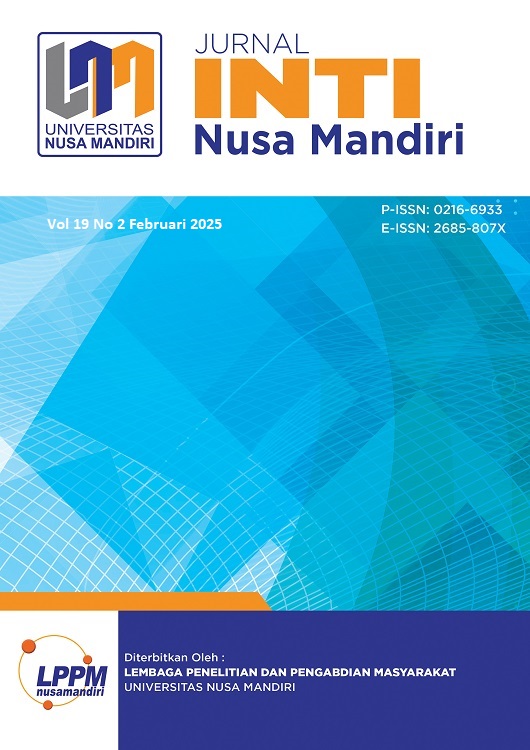PROTOTIPE KERAN AIR TANPA SENTUH DAN PENGUKUR SUHU TUBUH OTOMATIS BERBASIS MIKROKONTROLLER ARDUINO UNO
DOI:
https://doi.org/10.33480/inti.v19i2.6417Keywords:
microcontroller, pandemic, prototype, ultrasonic HC-SR04, water tapAbstract
The global pandemic requires the development of technological solutions to minimize physical contact, especially in public facilities such as water taps, which can function as a medium for transmitting infectious diseases. This study aims to design and develop a prototype of an automatic water tap integrated with an Arduino Uno microcontroller-based body temperature meter. This system was created to support health protocol efforts when carrying out activities, increasing efficiency and reducing the risk of disease transmission. The research method includes problem identification, literature study, hardware and software component design, prototyping, and functionality testing. The test results obtained show that all components work according to their functions with a high level of accuracy, such as the HC-SR04 ultrasonic sensor, which is able to detect objects at a distance between the object and the sensor <12cm, then the Relay will be active and the Mini Water Pump will pump water automatically, and the Valve on the Solenoid Valve will open, and water will flow automatically through the water tap. The test results on the MLX-90614 temperature sensor also obtained an average difference of only 0.28 ° C compared to the thermometer gun as a comparison.
Downloads
References
Anam, R., Arifin, S., & Islamiyah, M. (2021). Sistem Program Smart Gate Berbasis Indikator Suhu Dan Wastafel Otomatis. POSITIF : Jurnal Sistem Dan Teknologi Informasi, 7(2), 127–134. https://doi.org/10.31961/positif.v7i2.1238
Asrul, A., Sahidin, S., & Alam, S. (2021). Mesin Cuci Tangan Otomatis Menggunakan Sensor Proximity dan DFPlayer Mini Berbasis Arduino Uno. Jurnal Mosfet, 1(1), 1–7. https://doi.org/10.31850/jmosfet.v1i1.633
Chairil, S., Radillah, T., & Satria, B. (2023). Sistem Kontrol Menghidupkan Lampu Otomatis Menggunakan Sensor Suara FC-04 Berbasis Arduino Uno. Indonesian Journal of Computer Science, 12(1), 216–224. https://doi.org/10.33022/ijcs.v12i1.3121
Faadhil, A. M., Nawangsah, G., Mukminin, & Saptan, L. S. (2023). Otomatisasi Kran Air dan Sabun di RW 08 KelurahanJoharBaru Berbasis Sensor HC- SR04 dan Panel Surya. Jurnal Pengabdian Kepada Masyarakat Nusantara (JPkMN), 3(2), 1841–1851.
Fauza, N., Syaflita, D., Jati, D. W., Farliani, D., Yoeliana, R., Salmah, U., Haidi, R. Z., & Anjeli, C. (2021). Design of Automatic Sink by Using Photodiode Sensor. Jurnal Ilmu Fisika Dan Pembelajarannya, 5(2), 25–30.
Hakim, M. H., Irmawanto, R., & Poniman, P. (2021). Rancang Bangun Wastafel dan Portal Otomatis dengan Mempertimbangkan Antropometri Guna Mencegah Penularan COVID19. RESISTOR (Elektronika Kendali Telekomunikasi Tenaga Listrik Komputer), 4(1), 29–36. https://doi.org/10.24853/resistor.4.1.29-36
Jatmika, S., Aprilianto, T., & Burhanudin, D. (2022). Sistem Smart Gate Dengan Menggunakan Wastafel Dan Sensor Suhu Touchless Sensor Berbasis Fuzyy Logic Control. POSITIF : Jurnal Sistem Dan Teknologi Informasi, 8(1), 8–17. https://doi.org/10.31961/positif.v8i1.1262
Lesmana, D., Satria, B., & Sari, Y. R. (2020). Robot ARM (Advanced Riscmachine) Automatic Item Transfer Based On Color Using Arduino Uno R3. Jurnal Teknologi Dan Open Source, 3(2), 176–186.
Majid, S. I., Alvian, M., Prastya, B., Pramudya, R., & Pramono. (2024). Rancangan Alat Cuci Tangan Tanpa Sentuh Dan Monitoring Sabun Berbasis Sensor. Seminar Nasional Teknologi Informasi Dan Bisnis (SENATIB) 2024, 348–355.
Nasri, Asmira, & Bakrim, L. O. (2022). Perancangan Keran Westafel Otomatis Menggunakan Sensor Ir dan Micro Servo Berbasis Mikrokontroler. Jurnal Sistem Informasi Dan Sistem Komputer, 7(1), 42–49. https://doi.org/10.51717/simkom.v7i1.71
Nugraha, D. A., & Satria, B. (2022). Prototype Alat Pendeteksi kebakaran Menggunakan Sensor Flame dan MQ-2 Berbasis Arduino Uno. Indonesian Journal of Computer Science, 11(3), 936–944.
Putra, A. F., Aziz, A., & Kartika, I. (2021). Rancang Bangun Alat Cuci Tangan Pintar Menggunakan Sensor Infrared Berbasis Arduino. Jurnal Rekayasa Dan Teknologi Elektro, 15(3), 224–238. https://doi.org/10.23960/elc.v15n3.2177
Putra, B. P., Satria, B., Murni, A., Surya, C., & Sakinah, P. (2024). IMPLEMENTASI METODE WATERFALL DAN SYSTEM USABILITY SCALE TESTING PADA APLIKASI FISIOTERAPI PASIEN BPJS. INTI Nusa Mandiri, 19(1), 31–39.
Setiawan, D., Widiatmoko, I., Ariska, A. M., & Komariah, A. (2022). Rancangan Keran Wastafel Otomatis dengan Sensor Ultrasonic Berbasis Controller Arduino Nano Guna Memutus Rantai Penyebaran Covid-19. Seminar Nasional UNIBA Surakarta, 978–979.
Wahyudi, M. I., & Aziz, R. A. (2022). Keran Air Wudhu Otomatis Menggunakan Sensor Infrared Sebagai Upaya Meminimalisasi Pemborosan Air. Journal of Applied Computer Science and Technology, 3(1), 151–156. https://doi.org/10.52158/jacost.v3i1.296
Wulandari, S., & Satria, B. (2021). Rancang Bangun Alat Pendeteksi Warna Menggunakan Arduino Uno Berbasis IoT (Internet Of Things). Paradigma - Jurnal Komputer Dan Informatika, 23(1), 1–8. https://doi.org/10.31294/p.v23i1.9861.
Downloads
Published
How to Cite
Issue
Section
License
Copyright (c) 2025 Firma Firma, Budy Satria, Muhammad Al Ashari

This work is licensed under a Creative Commons Attribution-NonCommercial 4.0 International License.
Penulis yang menerbitkan jurnal ini menyetujui ketentuan berikut:
1. Penulis memegang hak cipta dan memberikan hak jurnal mengenai publikasi pertama dengan karya yang dilisensikan secara bersamaan di bawah Creative Commons Attribution 4.0 International License. yang memungkinkan orang lain untuk berbagi karya dengan pengakuan atas karya penulis dan publikasi awal pada jurnal.
2. Penulis dapat memasukkan pengaturan kontrak tambahan yang terpisah untuk distribusi non-eksklusif dari versi jurnal yang diterbitkan (misalnya, mengirimkannya ke repositori institusional atau menerbitkannya dalam sebuah buku), dengan pengakuan atas publikasi awalnya pada Jurnal.
3. Penulis diizinkan dan didorong untuk memposting karya mereka secara online (misalnya, dalam penyimpanan institusional atau di situs web mereka) sebelum dan selama proses pengiriman, karena hal itu dapat menghasilkan pertukaran yang produktif, serta kutipan dari karya yang diterbitkan sebelumnya.











